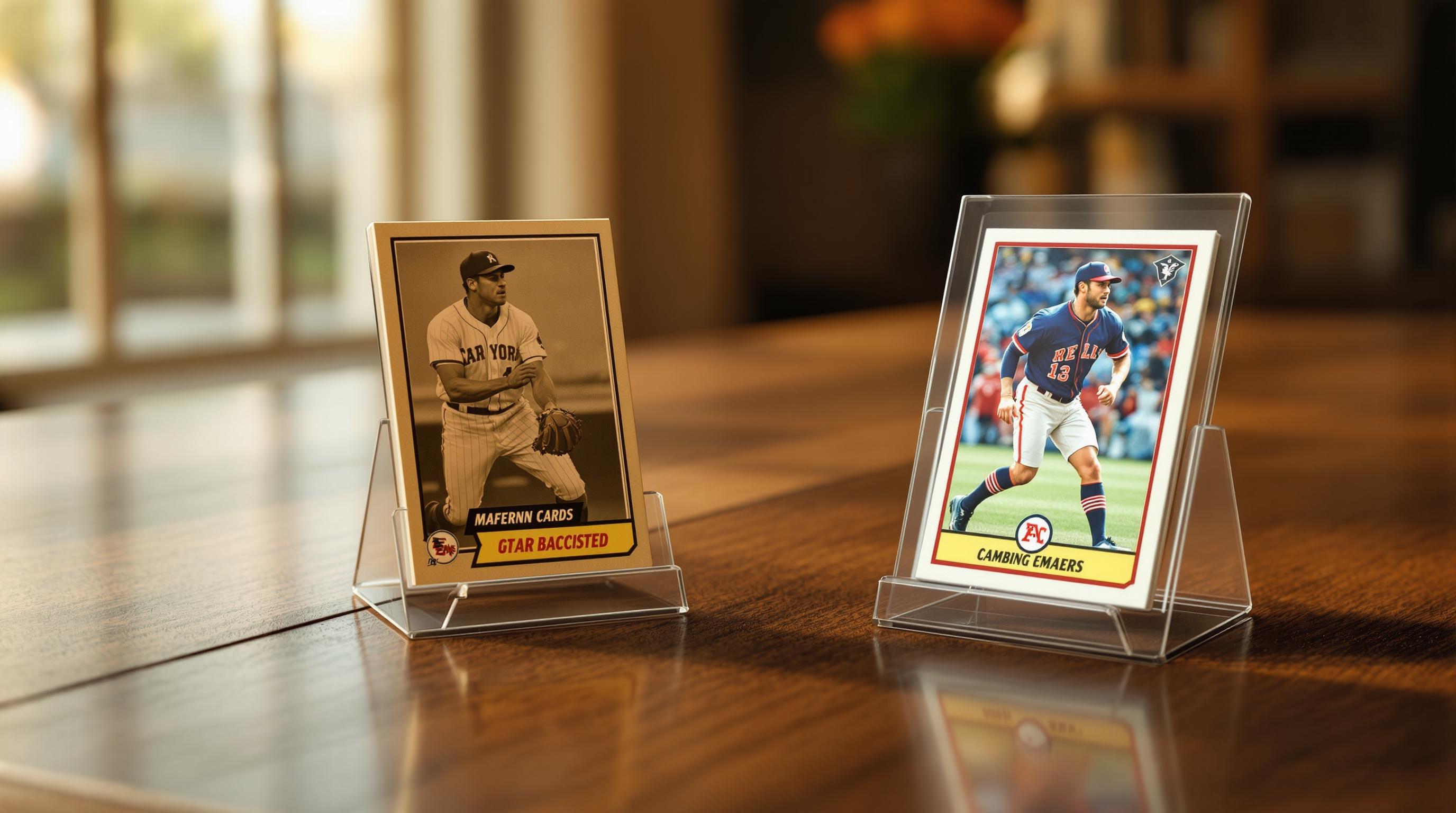Understanding the value of trading cards is essential for collectors and investors. Here's a quick breakdown of what impacts card values and how to evaluate them:
- Key Factors Affecting Value:
-
How to Determine Value:
- Use online platforms like eBay (check sold listings) and TCGPlayer for accurate pricing.
- Visit local card shops for expert evaluations and market insights.
- Combine grading services and market research for precise valuations.
-
Market Trends:
- Vintage cards (e.g., 1980s/1990s) and trading card games like Pokémon remain popular.
- Tools like Ludex simplify price tracking and card authentication.
To succeed, stay updated on trends, use professional grading, and protect your cards to maintain their value. Ready to dive deeper? Let’s explore the details!
What Affects the Value of Trading Cards
Card Condition
The condition of a trading card plays a huge role in its value. Features like proper centering, clean edges, a smooth surface, and intact corners are critical. Even small flaws can drastically reduce a card's worth. For instance, a card graded 9 might sell for about half the price of the same card graded 10 [1]. This shows how much collectors prioritize cards in perfect condition.
Rarity, Scarcity, and Market Demand
The rarity of a card and the demand for it are major factors in determining its price. Limited editions, special variants, or older prints tend to attract more interest due to their scarcity. However, market demand - driven by events, collector preferences, or trends - ultimately dictates how much someone is willing to pay. For example, a player's major achievement or media coverage can lead to a temporary surge in the value of their cards.
Professional Grading Services
Professional grading has become a cornerstone of trading card valuation. Companies like PSA, BGS, and SGC offer grading services that authenticate and standardize evaluations. PSA is widely regarded as the industry leader, BGS provides detailed subgrades, and SGC is known for its faster turnaround times [5][6]. A professionally graded card often sees a significant boost in value, especially if it receives a high grade.
These factors are crucial to understand before diving into specific strategies for assessing a card's worth.
Steps to Find Out a Card's Value
Using Online Marketplaces and Price Guides
Platforms like eBay are great for checking a card's market value. Focus on sold listings rather than active ones, as they reflect what buyers are actually paying. For trading card games, TCGPlayer is another reliable source for up-to-date market prices.
If you're dealing with sports cards, check out platforms like Sports Card Investor, which provide detailed price histories and market trends [4]. When researching, compare cards with similar grades and conditions, and stick to recent sales data since prices can change quickly.
After gathering price information, the next step is to evaluate your card's physical condition to fine-tune its worth.
Evaluating Card Condition
Card grading revolves around four main factors: centering (even borders), corners (sharp and clean), edges (smooth and consistent), and surface (free of scratches or marks). Cards with higher grades can be worth significantly more - PSA 10 cards, for example, often sell for twice as much as PSA 9s [1].
Finding Shops with Card Shops List

Online tools are helpful, but local shops listed on Card Shops List can give you hands-on evaluations and trading opportunities. These shops offer expert opinions on card condition and insight into current market trends, especially based on local demand.
For quick price estimates, apps like Ludex can be useful, but it's best to pair them with professional evaluations [7]. Combining local expertise with online data gives you a more complete picture of your card's value.
Understanding Market Trends and What's Next
Popular Trends in Trading Cards
Vintage trading cards, especially from the 1980s and 1990s, have seen a surge in demand. For example, a PSA 10 Michael Jordan rookie card recently sold for over $2 million [1]. Tools like Ludex are making a big impact, simplifying the process of verifying cards and tracking their values in real-time [7].
Meanwhile, trading card games like Pokémon and Magic: The Gathering continue to lead the market. Each new release boosts interest and keeps collectors engaged. Local card shops are also stepping up by hosting tournaments and trading events, offering more than just a place to buy cards.
As these trends shift, collectors need to stay alert to both opportunities and challenges shaping the market's future.
What the Future Holds for Collectors
The trading card market is poised for further growth. Grading services are improving their methods to better serve modern collectors, giving investors more confidence in their purchases [5][6].
"Grading gives us a foundation to predict future card values." - Morrison Trading Post [3]
Blockchain technology and digital authentication are making waves, offering better ways to confirm a card's legitimacy and track ownership. Global interest is also pushing prices higher for rare cards, whether vintage or modern, hinting at a strong future for the hobby.
Staying updated with industry news is key. It helps collectors keep up with market trends and discover new releases. Attending card shows can also provide access to exclusive deals and expert advice. These shifts in the market not only affect the collector experience but also have a direct impact on card values. Staying on top of these changes is essential to navigating this dynamic space.
Leveraging technology, focusing on authenticity, and staying informed will be critical for collectors as the market continues to evolve.
sbb-itb-0db97a5
How to Grade Your Sports Cards 101
Conclusion: Key Takeaways on Card Values
Understanding trading card values requires a solid grasp of card condition, grading, and market trends. While grading provides a foundation for a card's value, its actual worth is shaped by market demand and trends. Services like PSA and BGS play a major role in standardizing evaluations, which heavily impact card pricing.
Grading can lead to dramatic differences in value, particularly for rare cards [1]. With more affordable grading options now available, collectors of all levels can evaluate their cards more easily. This accessibility has reshaped how cards are assessed and traded.
Card values are influenced by shifts in the market, collector interest, and broader economic factors [1][3]. Staying updated on these trends allows collectors to navigate changes and make the most of opportunities. For those seeking a hands-on approach, physical stores listed on Card Shops List offer direct access to cards and real-time market insights.
FAQs
Here are answers to some common questions collectors have about trading card values.
How do you determine the value of a trading card?
Several methods and resources can help you figure out a trading card's value. The PSA Online Price Guide is a great starting point, offering detailed listings for everything from baseball cards to Pokémon and Magic: The Gathering. It's updated regularly by hobby experts [4].
To get an accurate valuation, consider these approaches:
- Professional Grading: Grading services evaluate a card's condition, which greatly influences its value. These services typically cost $12–$25 and are especially important for high-value cards [2].
- Market Research: Use online tools like eBay and Ludex, alongside professional evaluations, to gauge a card's current market value [7].
- Local Experts: Visit physical card shops for in-person assessments. Resources like Card Shops List can help you find trusted stores that offer these services.
"Professional grading services like CGC Cards and BGS evaluate cards based on specific criteria such as centering, corners, edges, and surface quality. These grades help establish a card's authenticity and condition, which directly impacts its value." [5][6]
For the best results, combine these methods while keeping an eye on market trends and demand. Proper storage is also crucial to maintaining a card's condition and value.


